Sandy Beach Extraction Method Based on Multi-Source Data and Feature Optimization: A Case in Fujian Province, China
Abstract
1. Introduction
2. Materials and Methods
2.1. Study Area
2.2. Data Sources and Processing
2.2.1. Reference Data for Supervised Classification
2.2.2. Remote Sensing Imagery Data
2.2.3. Other Data
2.3. Methods
2.3.1. Overview of the Methodology
2.3.2. Feature Extraction
2.3.3. Feature Selection
2.3.4. Sandy Beach Extraction
3. Results
3.1. Preliminary Feature Selection Results
3.2. Multi-Model RFE Results
3.3. Comparison of Model Results
4. Discussion
4.1. Evolution of Sandy Beach Extraction Strategies: From Spectrum Dominance to Multi-Feature Fusion
4.2. Analysis of Feature Type Distribution in the Optimal Feature Subset
4.3. Comparison of Product Results
4.4. Limitations and Future Work
5. Conclusions
- (1)
- Among all feature combinations, the fusion of five feature categories—S, I, T, P, and Tr—achieved the best performance, significantly outperforming any single type or partial combination of features. Multidimensional feature fusion effectively compensates for the limitations of individual features, enhances the model’s discrimination capability and robustness, and is a key factor in improving the accuracy of sandy beach extraction.
- (2)
- Through a multi-model RFE strategy, iterative selection was performed on the five categories of features. The results show that, even with fewer selected key features, the model performance not only remained unaffected but often improved, demonstrating the significant advantage of feature optimization in enhancing both accuracy and computational efficiency. Among the features, spectrum and terrain features ranked highest in importance, particularly mid-band reflectance and elevation information, which played critical roles in model discrimination. Polarization, index, and texture features exhibited strong complementarity across different models. This optimization strategy effectively reduced feature redundancy, improved model generalization and robustness, and provided a reliable foundation for efficient and accurate sandy beach extraction.
- (3)
- Compared to six other models, the Stacking model, using the optimal feature subset (Elevation, SAVG, NDUI, EWI, NDTI, Slope, VAR, CORR, B2, VH, NDSI, NDVI, B3, VVVH_SUM, Contrast, B12, Aspect, VV, B5, VI, VVVH_DIFF, EVI, BSI, B11, B4), achieved accuracy, precision, recall, and F1-score values of 0.9750, 0.9733, 0.9725, and 0.9734, respectively. This demonstrates its superior comprehensive performance and stability, making it a highly recommended model for large-scale, high-precision sandy beach extraction tasks.
Author Contributions
Funding
Data Availability Statement
Acknowledgments
Conflicts of Interest
Appendix A
| Feature Combinations | Description |
|---|---|
| S | B2, B3, B4, B5, B6, B7, B8, B8A, B11, B12 |
| I | NDVI, NDSI, NDBI, EVI, SAVI, BSI, NDUI, VI, LSWI, MNDWI, NDTI, RVI, DVI, MSAVI, EWI, BMI |
| P | VV, VH, VVVH_RI, VVVH_DIFF, VVVH_SUM, VVVH_NOR |
| T | ASM, Contrast, CORR, DISS, ENT, IDM, SAVG, VAR |
| Tr | Elevation, Hillshade, Slope, Aspect |
| S + I | B2, B3, B4, B5, B6, B7, B8, B8A, B11, B12, NDVI, NDSI, NDBI, EVI, SAVI, BSI, NDUI, VI, LSWI, MNDWI, NDTI, RVI, DVI, MSAVI, EWI, BMI |
| S + P | B2, B3, B4, B5, B6, B7, B8, B8A, B11, B12, VV, VH, VVVH_RI, VVVH_DIFF, VVVH_SUM, VVVH_NOR |
| S + T | B2, B3, B4, B5, B6, B7, B8, B8A, B11, B12, ASM, Contrast, CORR, DISS, ENT, IDM, SAVG, VAR |
| S + Tr | B2, B3, B4, B5, B6, B7, B8, B8A, B11, B12, Elevation, Hillshade, Slope, Aspect |
| I + P | NDVI, NDSI, NDBI, EVI, SAVI, BSI, NDUI, VI, LSWI, MNDWI, NDTI, RVI, DVI, MSAVI, EWI, BMI, VV, VH, VVVH_RI, VVVH_DIFF, VVVH_SUM, VVVH_NOR |
| I + T | NDVI, NDSI, NDBI, EVI, SAVI, BSI, NDUI, VI, LSWI, MNDWI, NDTI, RVI, DVI, MSAVI, EWI, BMI, ASM, Contrast, CORR, DISS, ENT, IDM, SAVG, VAR |
| I + Tr | NDVI, NDSI, NDBI, EVI, SAVI, BSI, NDUI, VI, LSWI, MNDWI, NDTI, RVI, DVI, MSAVI, EWI, BMI, Elevation, Hillshade, Slope, Aspect |
| P + T | VV, VH, VVVH_RI, VVVH_DIFF, VVVH_SUM, VVVH_NOR, ASM, Contrast, CORR, DISS, ENT, IDM, SAVG, VAR |
| P + Tr | VV, VH, VVVH_RI, VVVH_DIFF, VVVH_SUM, VVVH_NOR, Elevation, Hillshade, Slope, Aspect |
| T + Tr | ASM, Contrast, CORR, DISS, ENT, IDM, SAVG, VAR, Elevation, Hillshade, Slope, Aspect |
| S + I + P | B2, B3, B4, B5, B6, B7, B8, B8A, B11, B12, NDVI, NDSI, NDBI, EVI, SAVI, BSI, NDUI, VI, LSWI, MNDWI, NDTI, RVI, DVI, MSAVI, EWI, BMI, VV, VH, VVVH_RI, VVVH_DIFF, VVVH_SUM, VVVH_NOR |
| S + I + T | B2, B3, B4, B5, B6, B7, B8, B8A, B11, B12, NDVI, NDSI, NDBI, EVI, SAVI, BSI, NDUI, VI, LSWI, MNDWI, NDTI, RVI, DVI, MSAVI, EWI, BMI, ASM, Contrast, CORR, DISS, ENT, IDM, SAVG, VAR |
| S + I + Tr | B2, B3, B4, B5, B6, B7, B8, B8A, B11, B12, NDVI, NDSI, NDBI, EVI, SAVI, BSI, NDUI, VI, LSWI, MNDWI, NDTI, RVI, DVI, MSAVI, EWI, BMI, Elevation, Hillshade, Slope, Aspect |
| S + P + T | B2, B3, B4, B5, B6, B7, B8, B8A, B11, B12, VV, VH, VVVH_RI, VVVH_DIFF, VVVH_SUM, VVVH_NOR, ASM, Contrast, CORR, DISS, ENT, IDM, SAVG, VAR |
| S + P + Tr | B2, B3, B4, B5, B6, B7, B8, B8A, B11, B12, VV, VH, VVVH_RI, VVVH_DIFF, VVVH_SUM, VVVH_NOR, Elevation, Hillshade, Slope, Aspect |
| S + T + Tr | B2, B3, B4, B5, B6, B7, B8, B8A, B11, B12, ASM, Contrast, CORR, DISS, ENT, IDM, SAVG, VAR, Elevation, Hillshade, Slope, Aspect |
| I + P + T | NDVI, NDSI, NDBI, EVI, SAVI, BSI, NDUI, VI, LSWI, MNDWI, NDTI, RVI, DVI, MSAVI, EWI, BMI, VV, VH, VVVH_RI, VVVH_DIFF, VVVH_SUM, VVVH_NOR, ASM, Contrast, CORR, DISS, ENT, IDM, SAVG, VAR |
| I + P + Tr | NDVI, NDSI, NDBI, EVI, SAVI, BSI, NDUI, VI, LSWI, MNDWI, NDTI, RVI, DVI, MSAVI, EWI, BMI, VV, VH, VVVH_RI, VVVH_DIFF, VVVH_SUM, VVVH_NOR, Elevation, Hillshade, Slope, Aspect |
| I + T + Tr | NDVI, NDSI, NDBI, EVI, SAVI, BSI, NDUI, VI, LSWI, MNDWI, NDTI, RVI, DVI, MSAVI, EWI, BMI, ASM, Contrast, CORR, DISS, ENT, IDM, SAVG, VAR, Elevation, Hillshade, Slope, Aspect |
| P + T + Tr | VV, VH, VVVH_RI, VVVH_DIFF, VVVH_SUM, VVVH_NOR, ASM, Contrast, CORR, DISS, ENT, IDM, SAVG, VAR, Elevation, Hillshade, Slope, Aspect |
| S + I + P + T | B2, B3, B4, B5, B6, B7, B8, B8A, B11, B12, NDVI, NDSI, NDBI, EVI, SAVI, BSI, NDUI, VI, LSWI, MNDWI, NDTI, RVI, DVI, MSAVI, EWI, BMI, VV, VH, VVVH_RI, VVVH_DIFF, VVVH_SUM, VVVH_NOR, ASM, Contrast, CORR, DISS, ENT, IDM, SAVG, VAR |
| S + I + P + Tr | B2, B3, B4, B5, B6, B7, B8, B8A, B11, B12, NDVI, NDSI, NDBI, EVI, SAVI, BSI, NDUI, VI, LSWI, MNDWI, NDTI, RVI, DVI, MSAVI, EWI, BMI, VV, VH, VVVH_RI, VVVH_DIFF, VVVH_SUM, VVVH_NOR, Elevation, Hillshade, Slope, Aspect |
| S + I + T + Tr | B2, B3, B4, B5, B6, B7, B8, B8A, B11, B12, NDVI, NDSI, NDBI, EVI, SAVI, BSI, NDUI, VI, LSWI, MNDWI, NDTI, RVI, DVI, MSAVI, EWI, BMI, ASM, Contrast, CORR, DISS, ENT, IDM, SAVG, VAR, Elevation, Hillshade, Slope, Aspect |
| S + P + T + Tr | B2, B3, B4, B5, B6, B7, B8, B8A, B11, B12, VV, VH, VVVH_RI, VVVH_DIFF, VVVH_SUM, VVVH_NOR, ASM, Contrast, CORR, DISS, ENT, IDM, SAVG, VAR, Elevation, Hillshade, Slope, Aspect |
| I + P + T + Tr | NDVI, NDSI, NDBI, EVI, SAVI, BSI, NDUI, VI, LSWI, MNDWI, NDTI, RVI, DVI, MSAVI, EWI, BMI, VV, VH, VVVH_RI, VVVH_DIFF, VVVH_SUM, VVVH_NOR, ASM, Contrast, CORR, DISS, ENT, IDM, SAVG, VAR, Elevation, Hillshade, Slope, Aspect |
| S + I + P + T + Tr | B2, B3, B4, B5, B6, B7, B8, B8A, B11, B12, NDVI, NDSI, NDBI, EVI, SAVI, BSI, NDUI, VI, LSWI, MNDWI, NDTI, RVI, DVI, MSAVI, EWI, BMI, VV, VH, VVVH_RI, VVVH_DIFF, VVVH_SUM, VVVH_NOR, ASM, Contrast, CORR, DISS, ENT, IDM, SAVG, VAR, Elevation, Hillshade, Slope, Aspect |
| Feature Combinations | RF | XGB | LGBM | GBM | AdaBoost | CatBoost | Stacking |
|---|---|---|---|---|---|---|---|
| S | 0.9383 | 0.9402 | 0.9402 | 0.9334 | 0.9236 | 0.9379 | 0.9410 |
| I | 0.9405 | 0.9443 | 0.9451 | 0.9372 | 0.9222 | 0.9434 | 0.9459 |
| P | 0.8882 | 0.8859 | 0.8915 | 0.8911 | 0.8868 | 0.8930 | 0.8935 |
| T | 0.8256 | 0.8180 | 0.8273 | 0.8281 | 0.8180 | 0.8303 | 0.8310 |
| Tr | 0.8257 | 0.8376 | 0.8395 | 0.8411 | 0.8397 | 0.8421 | 0.8422 |
| S + I | 0.9481 | 0.9536 | 0.9541 | 0.9465 | 0.9406 | 0.9528 | 0.9544 |
| S + P | 0.9514 | 0.9528 | 0.9532 | 0.9459 | 0.9391 | 0.9511 | 0.9547 |
| S + T | 0.9480 | 0.9505 | 0.9511 | 0.9424 | 0.9356 | 0.9484 | 0.9525 |
| S + Tr | 0.9573 | 0.9618 | 0.9615 | 0.9555 | 0.9521 | 0.9575 | 0.9621 |
| I + P | 0.9503 | 0.9563 | 0.9569 | 0.9503 | 0.9409 | 0.9550 | 0.9580 |
| I + T | 0.9511 | 0.9558 | 0.9569 | 0.9489 | 0.9397 | 0.9554 | 0.9577 |
| I + Tr | 0.9552 | 0.9652 | 0.9651 | 0.9566 | 0.9529 | 0.9649 | 0.9659 |
| P + T | 0.9236 | 0.9216 | 0.9255 | 0.9248 | 0.9178 | 0.9270 | 0.9272 |
| P + Tr | 0.9322 | 0.9335 | 0.9365 | 0.9345 | 0.9309 | 0.9364 | 0.9375 |
| T + Tr | 0.9274 | 0.9268 | 0.9307 | 0.9287 | 0.9170 | 0.9302 | 0.9313 |
| S + I + P | 0.9569 | 0.9615 | 0.9621 | 0.9555 | 0.9498 | 0.9600 | 0.9621 |
| S + I + T | 0.9547 | 0.9610 | 0.9616 | 0.9544 | 0.9496 | 0.9600 | 0.9616 |
| S + I + Tr | 0.9612 | 0.9697 | 0.9700 | 0.9648 | 0.9629 | 0.9694 | 0.9708 |
| S + P + T | 0.9530 | 0.9580 | 0.9582 | 0.9503 | 0.9453 | 0.9577 | 0.9596 |
| S + P + Tr | 0.9636 | 0.9683 | 0.9686 | 0.9645 | 0.9601 | 0.9678 | 0.9689 |
| S + T + Tr | 0.9626 | 0.9678 | 0.9672 | 0.9631 | 0.9608 | 0.9681 | 0.9692 |
| I + P + T | 0.9558 | 0.9616 | 0.9621 | 0.9558 | 0.9499 | 0.9604 | 0.9626 |
| I + P + Tr | 0.9618 | 0.9700 | 0.9701 | 0.9659 | 0.9616 | 0.9693 | 0.9700 |
| I + T + Tr | 0.9634 | 0.9719 | 0.9712 | 0.9667 | 0.9637 | 0.9711 | 0.9719 |
| P + T + Tr | 0.9500 | 0.9547 | 0.9560 | 0.9536 | 0.9484 | 0.9558 | 0.9566 |
| S + I + P + T | 0.9599 | 0.9656 | 0.9660 | 0.9593 | 0.9548 | 0.9638 | 0.9660 |
| S + I + P + Tr | 0.9655 | 0.9732 | 0.9738 | 0.9690 | 0.9657 | 0.9731 | 0.9738 |
| S + I + T + Tr | 0.9659 | 0.9743 | 0.9747 | 0.9693 | 0.9670 | 0.9738 | 0.9752 |
| S + P + T + Tr | 0.9652 | 0.9709 | 0.9709 | 0.9671 | 0.9641 | 0.9704 | 0.9722 |
| I + P + T + Tr | 0.9653 | 0.9743 | 0.9749 | 0.9686 | 0.9670 | 0.9735 | 0.9746 |
| S + I + P + T + Tr | 0.9681 | 0.9760 | 0.9760 | 0.9716 | 0.9697 | 0.9754 | 0.9762 |
| Feature Combinations | RF | XGB | LGBM | GBM | AdaBoost | CatBoost | Stacking |
|---|---|---|---|---|---|---|---|
| S | 0.9343 | 0.9362 | 0.9363 | 0.9295 | 0.9193 | 0.9342 | 0.9372 |
| I | 0.9362 | 0.9404 | 0.9412 | 0.9334 | 0.9168 | 0.9395 | 0.9421 |
| P | 0.8804 | 0.8781 | 0.8836 | 0.8839 | 0.8778 | 0.8854 | 0.8859 |
| T | 0.8167 | 0.8094 | 0.8196 | 0.8220 | 0.8107 | 0.8225 | 0.8227 |
| Tr | 0.8219 | 0.8317 | 0.8335 | 0.8347 | 0.8338 | 0.8358 | 0.8347 |
| S + I | 0.9446 | 0.9503 | 0.9509 | 0.9432 | 0.9363 | 0.9494 | 0.9511 |
| S + P | 0.9479 | 0.9495 | 0.9498 | 0.9423 | 0.9353 | 0.9477 | 0.9512 |
| S + T | 0.9447 | 0.9472 | 0.9481 | 0.9393 | 0.9321 | 0.9453 | 0.9495 |
| S + Tr | 0.9544 | 0.9590 | 0.9590 | 0.9526 | 0.9493 | 0.9548 | 0.9594 |
| I + P | 0.9464 | 0.9532 | 0.9537 | 0.9467 | 0.9369 | 0.9518 | 0.9548 |
| I + T | 0.9479 | 0.9530 | 0.9541 | 0.9457 | 0.9359 | 0.9525 | 0.9549 |
| I + Tr | 0.9521 | 0.9627 | 0.9626 | 0.9536 | 0.9497 | 0.9625 | 0.9635 |
| P + T | 0.9179 | 0.9170 | 0.9205 | 0.9198 | 0.9115 | 0.9220 | 0.9220 |
| P + Tr | 0.9274 | 0.9295 | 0.9322 | 0.9305 | 0.9264 | 0.9322 | 0.9332 |
| T + Tr | 0.9235 | 0.9228 | 0.9271 | 0.9251 | 0.9118 | 0.9268 | 0.9277 |
| S + I + P | 0.9536 | 0.9587 | 0.9592 | 0.9524 | 0.9464 | 0.9573 | 0.9593 |
| S + I + T | 0.9517 | 0.9582 | 0.9591 | 0.9514 | 0.9462 | 0.9572 | 0.9591 |
| S + I + Tr | 0.9585 | 0.9676 | 0.9680 | 0.9624 | 0.9604 | 0.9673 | 0.9687 |
| S + P + T | 0.9497 | 0.9551 | 0.9553 | 0.9470 | 0.9415 | 0.9548 | 0.9565 |
| S + P + Tr | 0.9608 | 0.9660 | 0.9663 | 0.9621 | 0.9572 | 0.9657 | 0.9668 |
| S + T + Tr | 0.9601 | 0.9657 | 0.9650 | 0.9608 | 0.9582 | 0.9660 | 0.9670 |
| I + P + T | 0.9525 | 0.9589 | 0.9593 | 0.9528 | 0.9465 | 0.9579 | 0.9598 |
| I + P + Tr | 0.9587 | 0.9679 | 0.9681 | 0.9636 | 0.9589 | 0.9671 | 0.9678 |
| I + T + Tr | 0.9608 | 0.9700 | 0.9693 | 0.9645 | 0.9612 | 0.9692 | 0.9701 |
| P + T + Tr | 0.9465 | 0.9519 | 0.9530 | 0.9504 | 0.9448 | 0.9528 | 0.9534 |
| S + I + P + T | 0.9568 | 0.9631 | 0.9635 | 0.9563 | 0.9515 | 0.9614 | 0.9636 |
| S + I + P + Tr | 0.9627 | 0.9714 | 0.9720 | 0.9669 | 0.9635 | 0.9713 | 0.9720 |
| S + I + T + Tr | 0.9634 | 0.9726 | 0.9731 | 0.9673 | 0.9646 | 0.9721 | 0.9735 |
| S + P + T + Tr | 0.9626 | 0.9690 | 0.9689 | 0.9647 | 0.9618 | 0.9684 | 0.9703 |
| I + P + T + Tr | 0.9627 | 0.9726 | 0.9732 | 0.9665 | 0.9648 | 0.9717 | 0.9729 |
| S + I + P + T + Tr | 0.9657 | 0.9743 | 0.9744 | 0.9695 | 0.9677 | 0.9737 | 0.9746 |
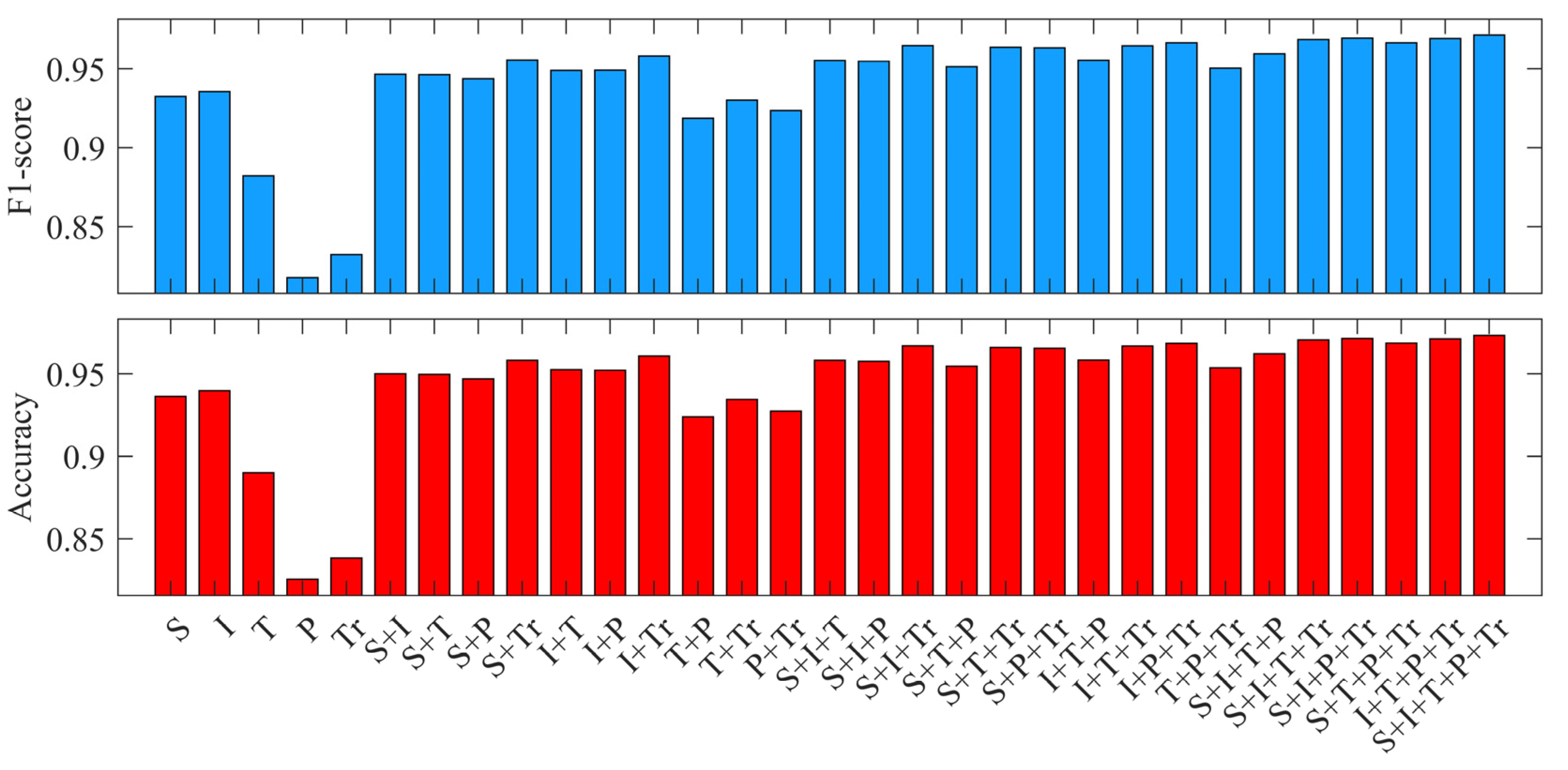
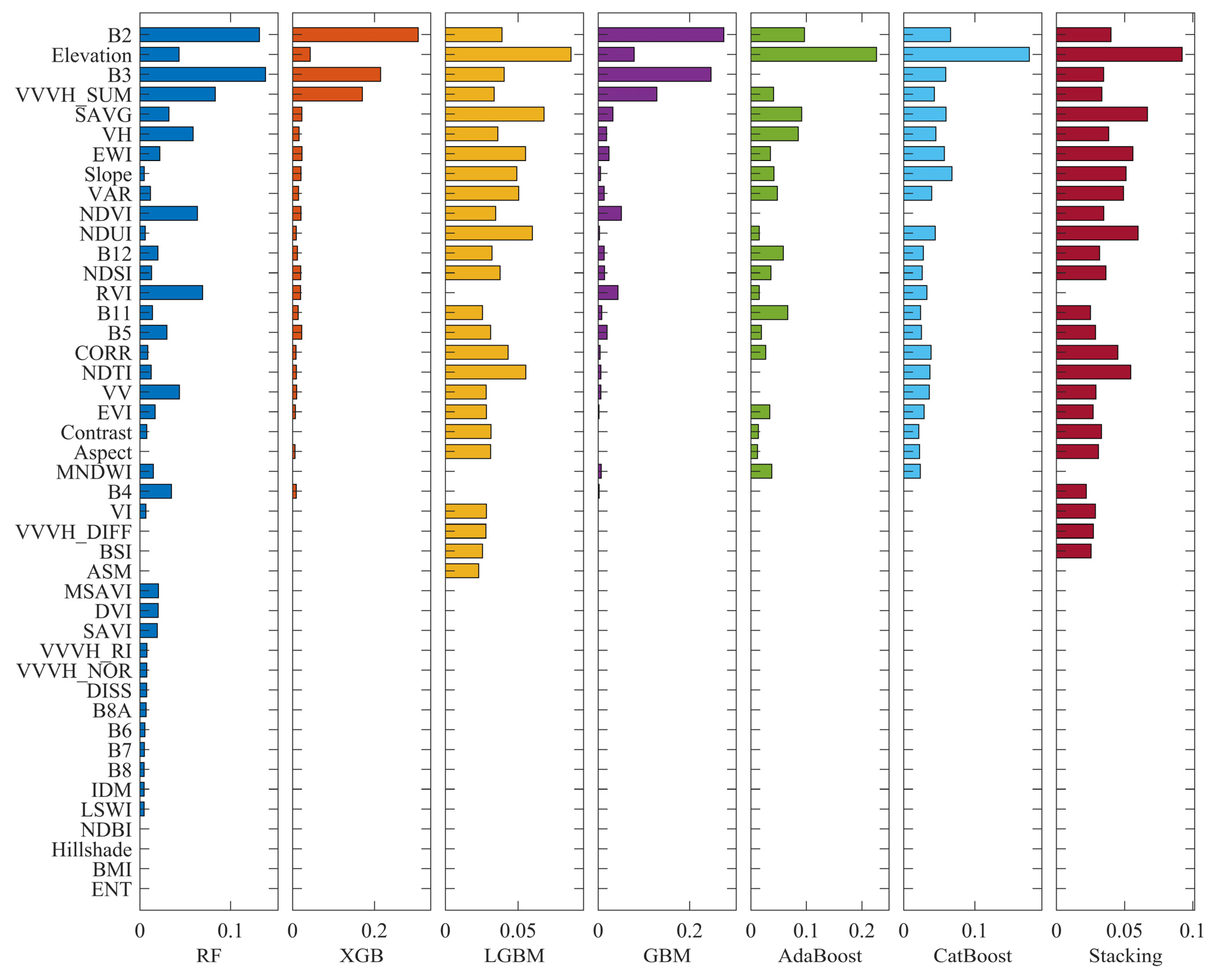

References
- Zhou, Z.; Wei, Y.; Geng, L.; Zhang, Y.; Gu, Y.; Finotello, A.; D’Alpaos, A.; Gong, Z.; Xu, F.; Zhang, C.; et al. Cross-Shore Parallel Tidal Channel Systems Formed by Alongshore Currents. Nat. Commun. 2024, 15, 4732. [Google Scholar] [CrossRef]
- Bozzeda, F.; Ortega, L.; Costa, L.L.; Fanini, L.; Barboza, C.A.M.; McLachlan, A.; Defeo, O. Global Patterns in Sandy Beach Erosion: Unraveling the Roles of Anthropogenic, Climatic and Morphodynamic Factors. Front. Mar. Sci. 2023, 10, 1270490. [Google Scholar] [CrossRef]
- Lansu, E.M.; Reijers, V.C.; Höfer, S.; Luijendijk, A.; Rietkerk, M.; Wassen, M.J.; Lammerts, E.J.; van der Heide, T. A Global Analysis of How Human Infrastructure Squeezes Sandy Coasts. Nat. Commun. 2024, 15, 432. [Google Scholar] [CrossRef]
- Mentaschi, L.; Vousdoukas, M.I.; Pekel, J.-F.; Voukouvalas, E.; Feyen, L. Global Long-Term Observations of Coastal Erosion and Accretion. Sci. Rep. 2018, 8, 12876. [Google Scholar] [CrossRef] [PubMed]
- Yuan, R.; Xu, R.; Zhang, H.; Hua, Y.; Zhang, H.; Zhong, X.; Chen, S. Detecting Shoreline Changes on the Beaches of Hainan Island (China) for the Period 2013–2023 Using Multi-Source Data. Water 2024, 16, 1034. [Google Scholar] [CrossRef]
- Sekar, C.S.; Kankara, R.S.; Kalaivanan, P. Pixel-Based Classification Techniques for Automated Shoreline Extraction on Open Sandy Coast Using Different Optical Satellite Images. Arab. J. Geosci. 2022, 15, 939. [Google Scholar] [CrossRef]
- Bao, Z.; Sha, J.; Li, X.; Hanchiso, T.; Shifaw, E. Monitoring of Beach Litter by Automatic Interpretation of Unmanned Aerial Vehicle Images Using the Segmentation Threshold Method. Mar. Pollut. Bull. 2018, 137, 388–398. [Google Scholar] [CrossRef]
- Zhu, Y.; Li, Z.; Zhao, Z.; Lu, L.; Yang, S.; Wang, Z. Spatio-Temporal Changes of Coastline in Jiaozhou Bay from 1987 to 2022 Based on Optical and SAR Data. Front. Mar. Sci. 2023, 10, 1233410. [Google Scholar] [CrossRef]
- Wu, J.; Li, Y.; Zhong, B.; Zhang, Y.; Liu, Q.; Shi, X.; Ji, C.; Wu, S.; Sun, B.; Li, C.; et al. Synergistic Coupling of Multi-Source Remote Sensing Data for Sandy Land Detection and Multi-Indicator Integrated Evaluation. Remote Sens. 2024, 16, 4322. [Google Scholar] [CrossRef]
- Wang, Z.; Fang, Z.; Chang, J.; Wang, Z.; Shen, W. A Two-Step Approach to Extracting Sandy Beaches Through Integrating Spatial Semantic Information from Open-Source Geospatial Datasets. Trans. GIS 2024, 28, 2379–2396. [Google Scholar] [CrossRef]
- Hu, L.; Xu, N.; Liang, J.; Li, Z.; Chen, L.; Zhao, F. Advancing the Mapping of Mangrove Forests at National-Scale Using Sentinel-1 and Sentinel-2 Time-Series Data with Google Earth Engine: A Case Study in China. Remote Sens. 2020, 12, 3120. [Google Scholar] [CrossRef]
- Xu, N.; Wang, L.; Xu, H.; Ma, Y.; Li, Y.; Wang, X.H. Deriving Accurate Intertidal Topography for Sandy Beaches Using ICESat-2 Data and Sentinel-2 Imagery. Remote Sens. 2024, 16, 305. [Google Scholar] [CrossRef]
- Sun, S.; Xue, Q.; Xing, X.; Zhao, H.; Zhang, F. Remote Sensing Image Interpretation for Coastal Zones: A Review. Remote Sens. 2024, 16, 4701. [Google Scholar] [CrossRef]
- Hu, F.; Li, Y.; Liang, J.; Li, Z.; Xie, M.; Chen, X.; Xiao, Z. History of Coastal Dune Evolution in the Fujian Region of Southeastern China over the Last Millennium. Mar. Geol. 2022, 451, 106878. [Google Scholar] [CrossRef]
- Jin, J.; Li, Z.; Jiang, F.; Deng, T.; Hu, F.; Ling, Z. Coastal Environment of the Past Millennium Recorded by a Coastal Dune in Fujian, China. J. Arid Land 2016, 8, 707–721. [Google Scholar] [CrossRef][Green Version]
- Li, M.; Chen, B.; Webster, C.; Gong, P.; Xu, B. The landea interface mapping: China’s coastal land covers at 10 m for 2020. Sci. Bull. 2022, 67, 1750–1754. [Google Scholar] [CrossRef] [PubMed]
- DeVries, B.; Huang, C.; Armston, J.; Huang, W.; Jones, J.W.; Lang, M.W. Rapid and robust monitoring of flood events using Sentinel-1 and Landsat data on the Google Earth Engine. Remote Sens. Environ. 2020, 240, 111664. [Google Scholar] [CrossRef]
- Yao, S.; Tan, K.; Wang, Y.; Zhang, W.; Liu, S.; Yang, J. Estimating terrain elevations at 10 m resolution by integrating random forest machine learning model and ICESat-2, Sentinel-1, and Sentinel-2 satellite remotely sensed data. Int. J. Appl. Earth Obs. Geoinf. 2024, 132, 104010. [Google Scholar] [CrossRef]
- Ezimand, K.; Aghighi, H.; Ashourloo, D.; Shakiba, A. The Analysis of the Spatio-Temporal Changes and Prediction of Built-Up Lands and Urban Heat Islands Using Multi-Temporal Satellite Imagery. Sustain. Cities Soc. 2024, 103, 105231. [Google Scholar] [CrossRef]
- Zhang, M.; Tan, S.; Zhang, C.; Han, S.; Zou, S.; Chen, E. Assessing the Impact of Fractional Vegetation Cover on Urban Thermal Environment: A Case Study of Hangzhou, China. Sustain. Cities Soc. 2023, 96, 104663. [Google Scholar] [CrossRef]
- Jia, M.; Wang, Z.; Mao, D.; Ren, C.; Wang, C.; Wang, Y. Rapid, Robust, and Automated Mapping of Tidal Flats in China Using Time Series Sentinel-2 Images and Google Earth Engine. Remote Sens. Environ. 2021, 255, 112285. [Google Scholar] [CrossRef]
- Li, H.; Jia, M.; Zhang, R.; Ren, Y.; Wen, X. Incorporating the Plant Phenological Trajectory into Mangrove Species Mapping with Dense Time Series Sentinel-2 Imagery and the Google Earth Engine Platform. Remote Sens. 2019, 11, 2479. [Google Scholar] [CrossRef]
- Lv, T.; Hu, H.; Han, H.; Zhang, X.; Fan, H.; Yan, K. Towards sustainability: The spatiotemporal patterns and influence mechanism of urban sprawl intensity in the Yangtze River Delta urban agglomeration. Habitat Int. 2024, 148, 103089. [Google Scholar] [CrossRef]
- Ni, M.; Xu, N.; Ou, Y.; Yao, J.; Li, Z.; Mo, F.; Huang, C.; Xin, H.; Xu, H. The first 10-m China’s national-scale sandy beach map in 2022 derived from Sentinel-2 imagery. Int. J. Digit. Earth 2024, 17, 2425163. [Google Scholar] [CrossRef]
- Luijendijk, A.; Hagenaars, G.; Ranasinghe, R.; Baart, F.; Donchyts, G.; Aarninkhof, S. The State of the World’s Beaches. Sci. Rep. 2018, 8, 6641. [Google Scholar] [CrossRef]
- Yin, Z.; Wu, P.; Li, X.; Hao, Z.; Ma, X.; Fan, R.; Liu, C.; Ling, F. Super-Resolution Water Body Mapping with a Feature Collaborative CNN Model by Fusing Sentinel-1 and Sentinel-2 Images. Int. J. Appl. Earth Obs. Geoinf. 2024, 134, 104176. [Google Scholar] [CrossRef]
- Zheng, Y.; Tang, L.; Wang, H. An Improved Approach for Monitoring Urban Built-Up Areas by Combining NPP-VIIRS Nighttime Light, NDVI, NDWI, and NDBI. J. Clean. Prod. 2021, 328, 129488. [Google Scholar] [CrossRef]
- Xiao, X.; Liang, S. Assessment of Snow Cover Mapping Algorithms from Landsat Surface Reflectance Data and Application to Automated Snowline Delineation. Remote Sens. Environ. 2024, 307, 114163. [Google Scholar] [CrossRef]
- Muhaimin, M.; Fitriani, D.; Adyatma, S.; Arisanty, D. Mapping Build-Up Area Density Using Normalized Difference Built-Up Index (NDBI) and Urban Index (UI) Wetland in the City Banjarmasin. IOP Conf. Ser. Earth Environ. Sci. 2022, 1089, 012036. [Google Scholar] [CrossRef]
- Wang, G.; Peng, W.; Zhang, L.; Zhang, J.; Xiang, J. Vegetation EVI Changes and Response to Natural Factors and Human Activities Based on Geographically and Temporally Weighted Regression. Glob. Ecol. Conserv. 2023, 45, e02531. [Google Scholar] [CrossRef]
- Xu, H.; Chen, J.; He, G.; Lin, Z.; Bai, Y.; Ren, M.; Zhang, H.; Yin, H.; Liu, F. Immediate Assessment of Forest Fire Using a Novel Vegetation Index and Machine Learning Based on Multi-Platform, High Temporal Resolution Remote Sensing Images. Int. J. Appl. Earth Obs. Geoinf. 2024, 134, 104210. [Google Scholar] [CrossRef]
- Ni, R.; Tian, J.; Li, X.; Yin, D.; Li, J.; Gong, H.; Zhang, J.; Zhu, L.; Wu, D. An Enhanced Pixel-Based Phenological Feature for Accurate Paddy Rice Mapping with Sentinel-2 Imagery in Google Earth Engine. ISPRS J. Photogramm. Remote Sens. 2021, 178, 282–296. [Google Scholar] [CrossRef]
- Zhang, Q.; Li, B.; Thau, D.; Moore, R. Building a Better Urban Picture: Combining Day and Night Remote Sensing Imagery. Remote Sens. 2015, 7, 11887–11913. [Google Scholar] [CrossRef]
- He, Y.; Zhang, B.; Ma, C. The Impact of Dynamic Change of Cropland on Grain Production in Jilin. J. Geogr. Sci. 2004, 14 (Suppl. S1), 56–62. [Google Scholar] [CrossRef]
- Chandrasekar, K.; Sesha Sai, M.V.R.; Roy, P.S.; Dwevedi, R.S. Land Surface Water Index (LSWI) Response to Rainfall and NDVI Using the MODIS Vegetation Index Product. Int. J. Remote Sens. 2010, 31, 3987–4005. [Google Scholar] [CrossRef]
- Tellman, B.; Sullivan, J.A.; Kuhn, C.; Kettner, A.J.; Doyle, C.S.; Brakenridge, G.R.; Erickson, T.A.; Slayback, D.A. Satellite Imaging Reveals Increased Proportion of Population Exposed to Floods. Nature 2021, 596, 80–86. [Google Scholar] [CrossRef] [PubMed]
- Fernández-Buces, N.; Siebe, C.; Cram, S.; Palacio, J.L. Mapping Soil Salinity Using a Combined Spectral Response Index for Bare Soil and Vegetation: A Case Study in the Former Lake Texcoco, Mexico. J. Arid Environ. 2006, 65, 644–667. [Google Scholar] [CrossRef]
- Li, C.; Lin, L.; Hao, Z.; Post, C.J.; Chen, Z.; Liu, J.; Yu, K. Developing a USLE Cover and Management Factor (C) for Forested Regions of Southern China. Front. Earth Sci. 2020, 14, 660–672. [Google Scholar] [CrossRef]
- Zhang, Y.; Wang, Y.; Ding, N.; Yang, X. Assessing the Contributions of Urban Green Space Indices and Spatial Structure in Mitigating Urban Thermal Environment. Remote Sens. 2023, 15, 2414. [Google Scholar] [CrossRef]
- Wang, S.; Baig, M.H.A.; Zhang, L.; Jiang, H.; Ji, Y.; Zhao, H.; Tian, J. A Simple Enhanced Water Index (EWI) for Percent Surface Water Estimation Using Landsat Data. IEEE J. Sel. Top. Appl. Earth Obs. Remote Sens. 2015, 8, 90–97. [Google Scholar] [CrossRef]
- Wang, R.; Qi, H.; Cai, F.; Yin, H.; Liu, G.; Zhao, S. Research on Beach Morphology Extraction Method Based on Beach Morphology Index. Mar. Bull. 2024, 43, 97–105. [Google Scholar]
- Jiang, W.; Tian, B.; Duan, Y.; Chen, C.; Hu, Y. Rapid Mapping and Spatial Analysis on the Distribution of Photovoltaic Power Stations with Sentinel-1 & 2 Images in Chinese Coastal Provinces. Int. J. Appl. Earth Obs. Geoinf. 2023, 118, 103280. [Google Scholar]
- Wang, L.; Wang, J.; Zhang, X.; Wang, L.; Qin, F. Deep Segmentation and Classification of Complex Crops Using Multi-Feature Satellite Imagery. Comput. Electron. Agric. 2022, 200, 107249. [Google Scholar] [CrossRef]
- Lin, J.; Jin, X.; Ren, J.; Liu, J.; Liang, X.; Zhou, Y. Rapid Mapping of Large-Scale Greenhouse Based on Integrated Learning Algorithm and Google Earth Engine. Remote Sens. 2021, 13, 1245. [Google Scholar] [CrossRef]
- Quartel, S.; Addink, E.A.; Ruessink, B.G. Object-Oriented Extraction of Beach Morphology from Video Images. Int. J. Appl. Earth Obs. Geoinf. 2006, 8, 256–269. [Google Scholar] [CrossRef]
- Sozio, A.; Scarrica, V.M.; Rizzo, A.; Aucelli, P.P.C.; Barracane, G.; Dimuccio, L.A.; Ferreira, R.; La Salandra, M.; Staiano, A.; Tarantino, M.P.; et al. Application of Direct and Indirect Methodologies for Beach Litter Detection in Coastal Environments. Remote Sens. 2024, 16, 3617. [Google Scholar] [CrossRef]
- Yin, H.; Cai, F.; Qi, H.; Jiang, Y.; Liu, G.; Cao, Z.; Sun, Y.; Xiao, Z. Analysis of Tidal Cycle Wave Breaking Distribution Characteristics on a Low-Tide Terrace Beach Using Video Imagery Segmentation. Remote Sens. 2024, 16, 4616. [Google Scholar] [CrossRef]
- Chen, Z.; Zhang, H.; Zhang, M.; Wu, Y.; Liu, Y. Mangrove Mapping in China Using Gaussian Mixture Model with a Novel Mangrove Index (SSMI) Derived from Optical and SAR Imagery. ISPRS J. Photogramm. Remote Sens. 2024, 218, 466–486. [Google Scholar] [CrossRef]
- Tian, P.; Liu, Y.; Li, J.; Pu, R.; Cao, L.; Zhang, H.; Ai, S.; Yang, Y. Mapping Coastal Aquaculture Ponds of China Using Sentinel SAR Images in 2020 and Google Earth Engine. Remote Sens. 2022, 14, 5372. [Google Scholar] [CrossRef]
- Mao, Y.; Harris, D.L.; Xie, Z.; Phinn, S. Global Coastal Geomorphology—Integrating Earth Observation and Geospatial Data. Remote Sens. Environ. 2022, 278, 113082. [Google Scholar] [CrossRef]
- Zhao, C.; Qin, C.-Z. 10-m-Resolution Mangrove Maps of China Derived from Multi-Source and Multi-Temporal Satellite Observations. ISPRS J. Photogramm. Remote Sens. 2020, 169, 389–405. [Google Scholar] [CrossRef]
- Belgiu, M.; Drăguţ, L. Random Forest in Remote Sensing: A Review of Applications and Future Directions. ISPRS J. Photogramm. Remote Sens. 2016, 114, 24–31. [Google Scholar] [CrossRef]
- Chen, B.; Huang, B.; Xu, B. Multi-Source Remotely Sensed Data Fusion for Improving Land Cover Classification. ISPRS J. Photogramm. Remote Sens. 2017, 124, 27–39. [Google Scholar] [CrossRef]
- Shirmard, H.; Farahbakhsh, E.; Müller, R.D.; Chandra, R. A Review of Machine Learning in Processing Remote Sensing Data for Mineral Exploration. Remote Sens. Environ. 2022, 268, 112750. [Google Scholar] [CrossRef]
- Talke, S.A. How Tidal Properties Influence the Future Duration of Coastal Flooding. npj Nat. Hazards 2025, 2, 36. [Google Scholar] [CrossRef]
- Zhou, Z.; Liang, M.; Chen, L.; Xu, M.; Chen, X.; Geng, L.; Li, H.; Serrano, D.; Zhang, H.; Gong, Z.; et al. Processes, Feedbacks, and Morphodynamic Evolution of Tidal Flat–Marsh Systems: Progress and Challenges. Water Sci. Eng. 2022, 15, 89–102. [Google Scholar] [CrossRef]
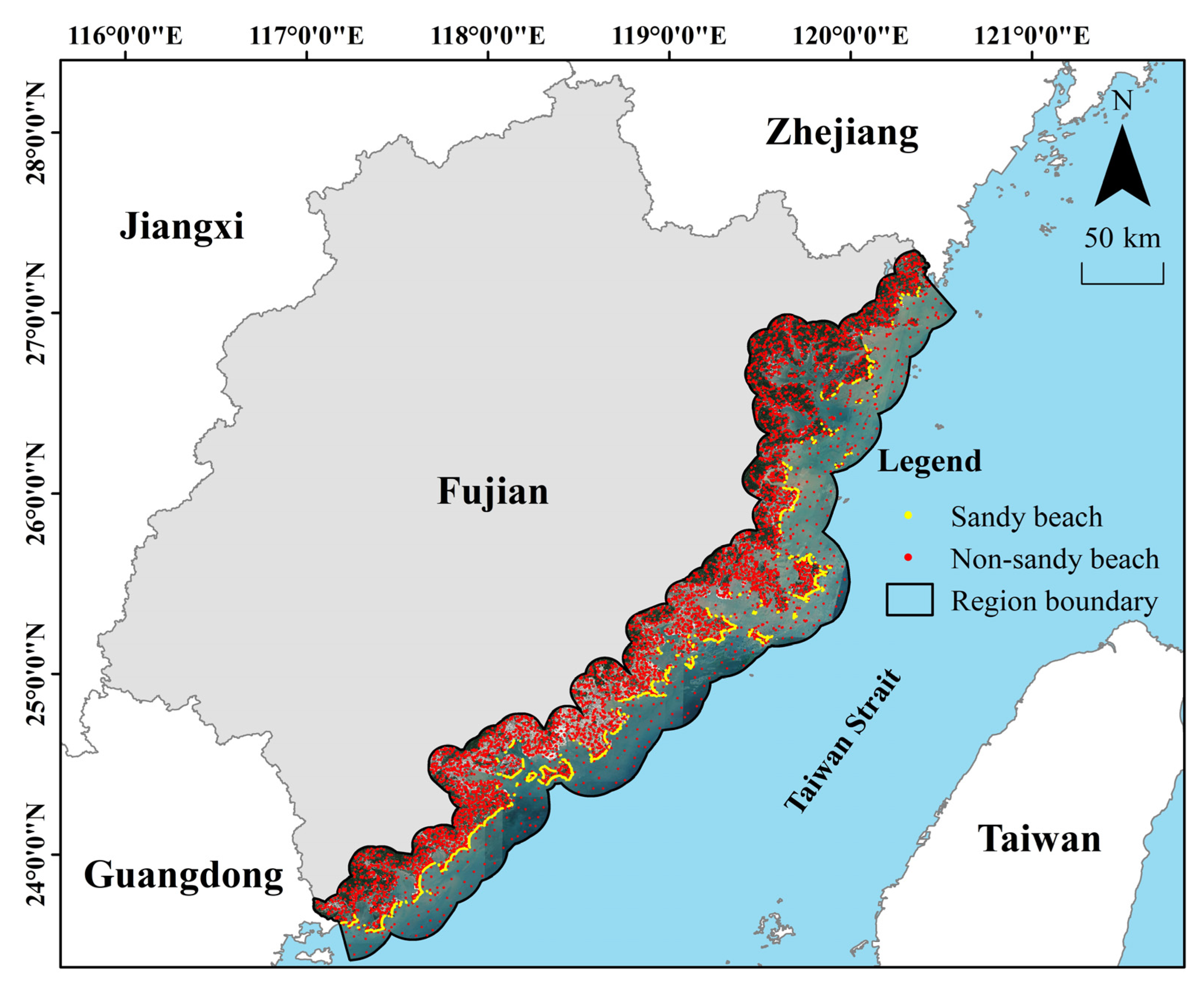


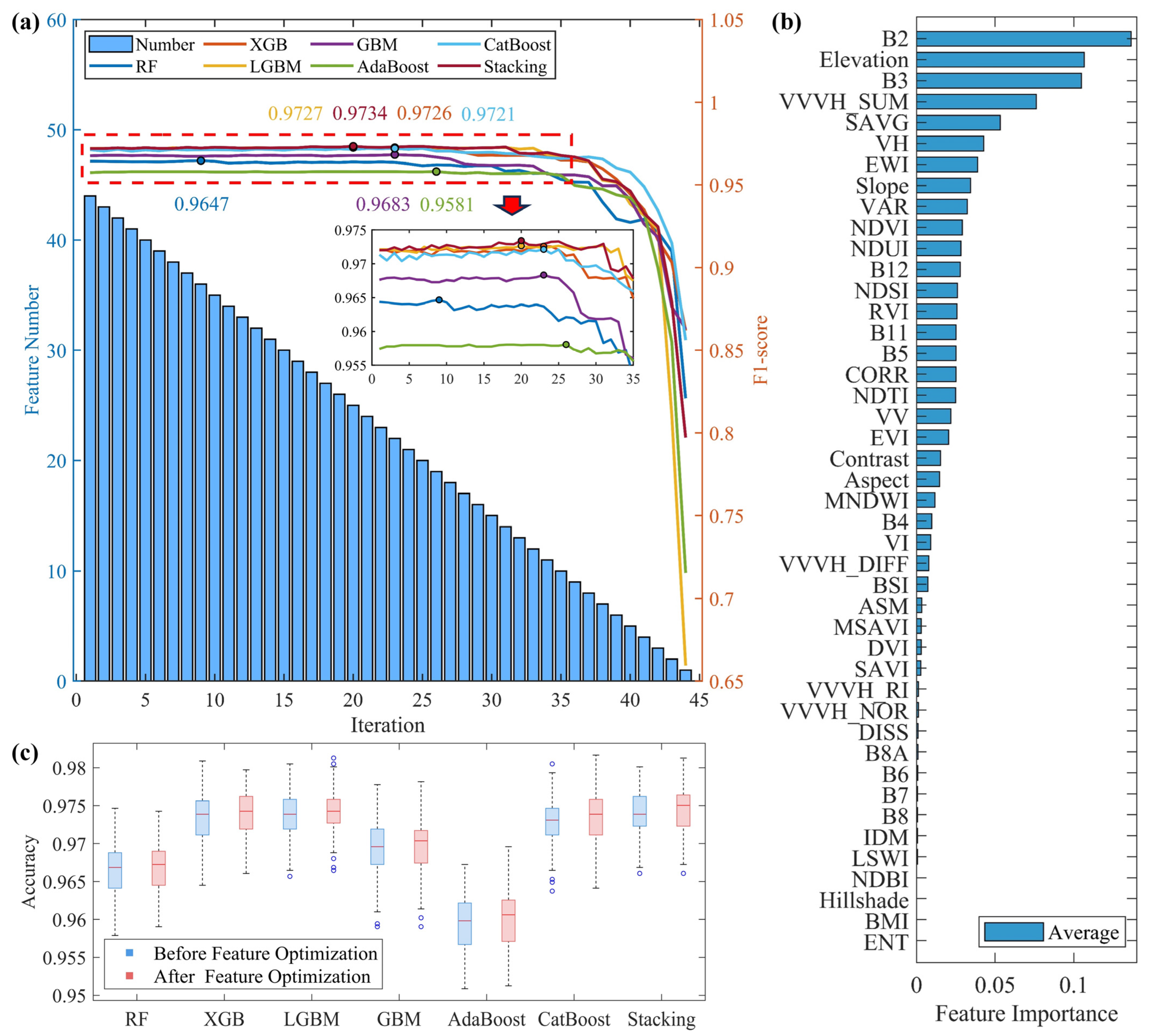
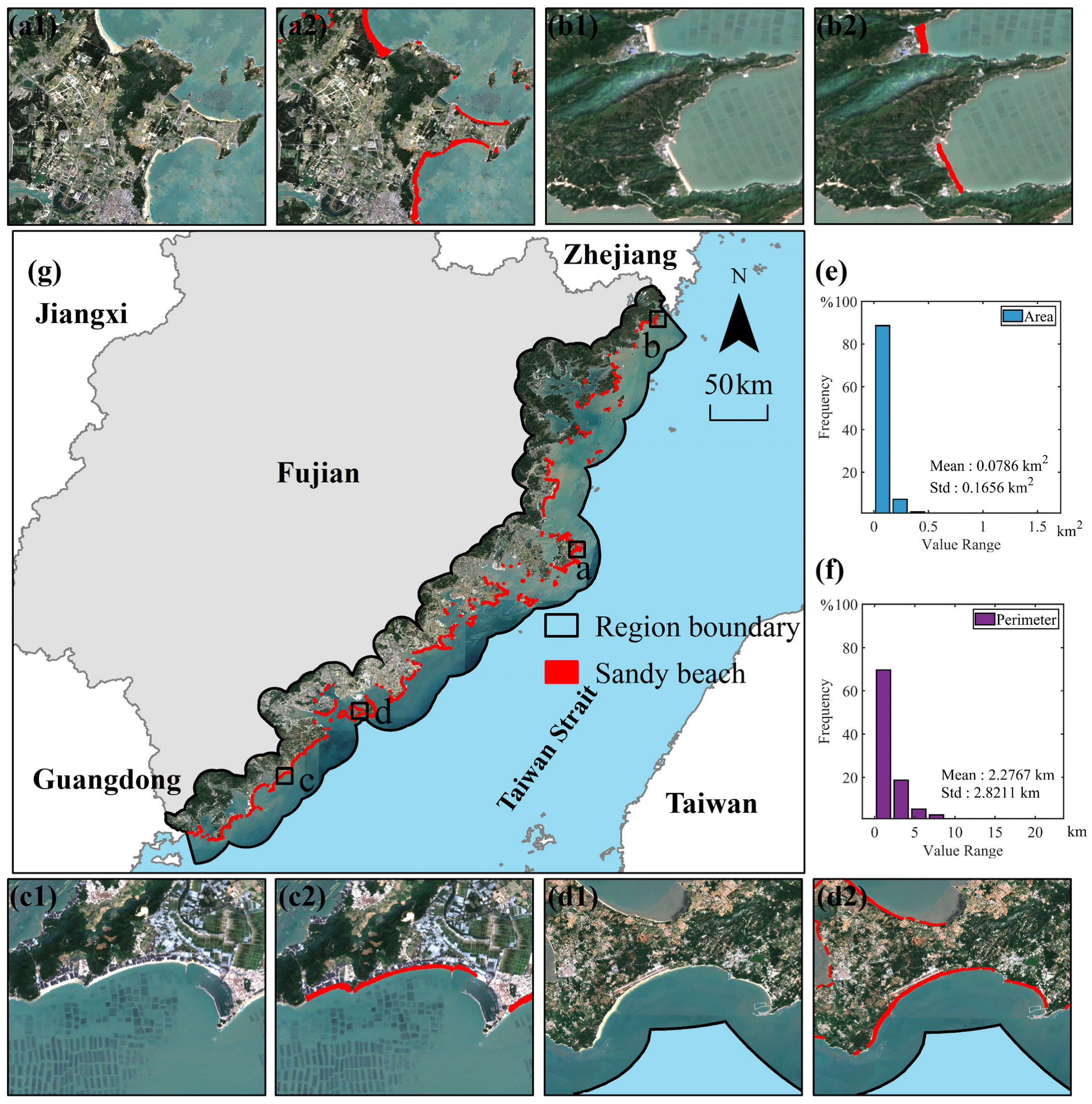
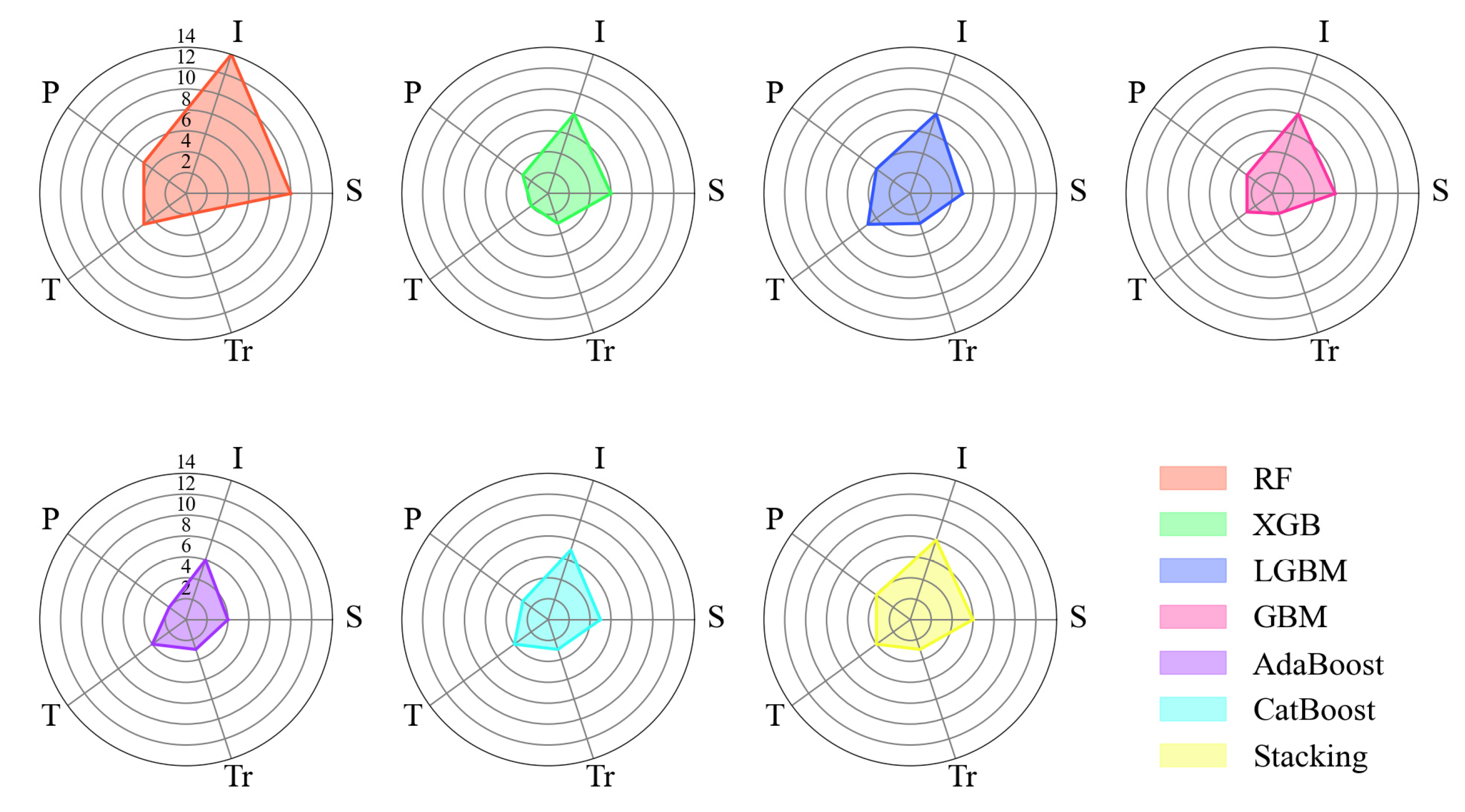

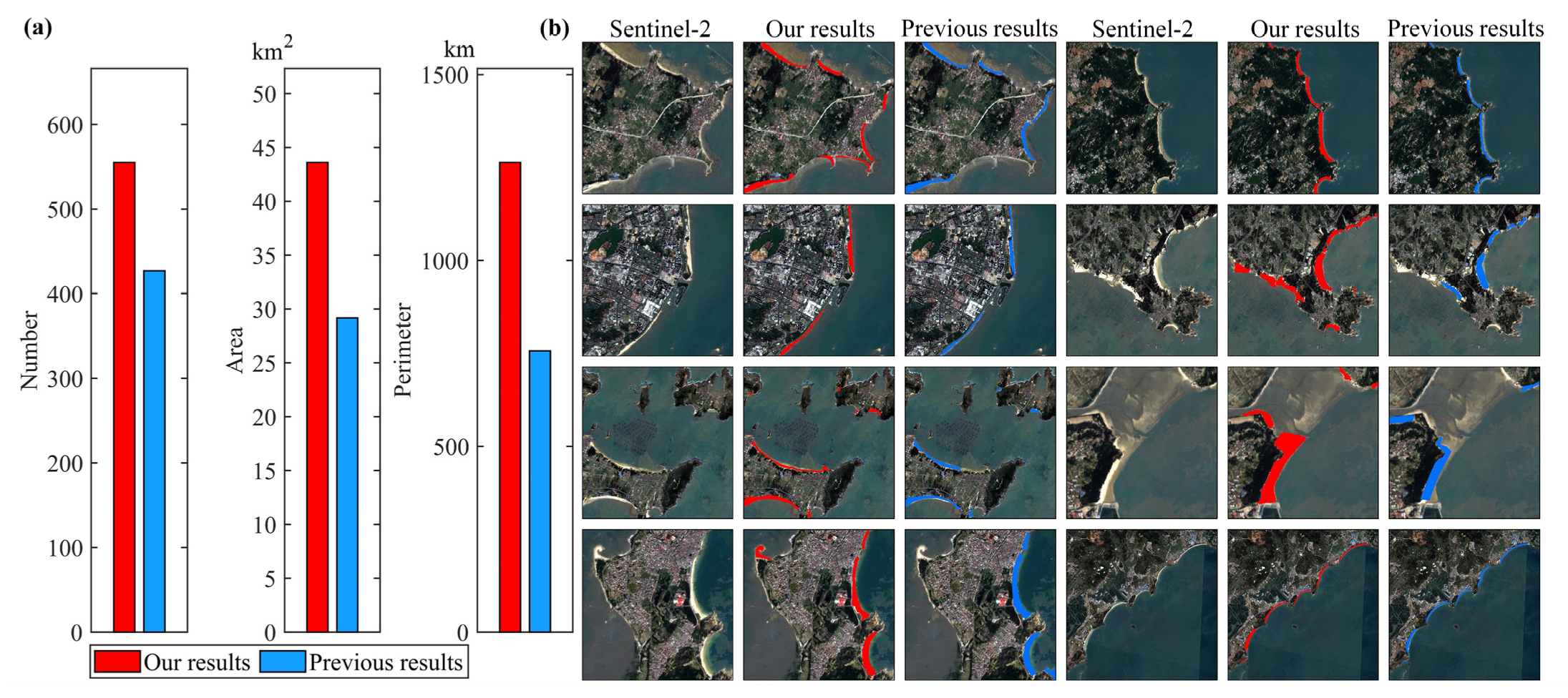
| Feature Types | Feature Factors | Calculation Methods | References |
|---|---|---|---|
| Spectrum Features (S) | B2, B3, B4, B5, B6, B7, B8, B8A, B11, B12 | Based on the preprocessed Sentinel-2 data, specific bands were selected. | Yin et al. [26] |
| Index Features (I) | Normalized Difference Vegetation Index (NDVI) | (B8 − B4)/(B8 + B4) | Zheng et al. [27] |
| Normalized Difference Snow Index (NDSI) | (B3 − B11)/(B3 + B11) | Xiao et al. [28] | |
| Normalized Difference Built-up Index (NDBI) | (B11 − B8)/(B11 + B8) | Muhaimin et al. [29] | |
| Enhanced Vegetation Index (EVI) | 2.5 × (B8 − B4)/(B8 + 6 × B4 − 7.5 × B2 + 1) | Wang et al. [30] | |
| Soil-Adjusted Vegetation Index (SAVI) | 1.5 × (B8 − B4)/(B8 + B4 + 0.5) | Xu et al. [31] | |
| Bare Soil Index (BSI) | ((B4 + B11) − (B8 + B2))/((B4 + B11) + (B8 + B2)) | Ni et al. [32] | |
| Normalized Difference Urban Index (NDUI) | (NTL − NDVI)/(NTL + NDVI) | Zhang et al. [33] | |
| Vegetation Index (VI) | ((B11 − B8)/(B11 + B8)) × ((B8 − B4)/(B8 + B4)) | He et al. [34] | |
| Land Surface Water Index (LSWI) | (B8 − B11)/(B8 + B11) | Chandrasekar et al. [35] | |
| Modified Normalized Difference Water Index (MNDWI) | (B3 − B11)/(B3 + B11) | Tellman et al. [36] | |
| Normalized Difference Tillage Index (NDTI) | (B11 − B12)/(B11 + B12) | Fernández-Buces et al. [37] | |
| Ratio Vegetation Index (RVI) | B8/B4 | Li et al. [38] | |
| Difference Vegetation Index (DVI) | B8 − B4 | ||
| Modified Soil-Adjusted Vegetation Index (MSAVI) | ((2 × B8 + 1) − (((2 × B8 + 1)2 − 8 × (B8 − B4))0.5)2)/2 | Zhang et al. [39] | |
| Enhanced Water Index (EWI) | ((B3 − B11)/(B3 + B11)] + ((B3 − B8)/(B3 + B8)) − ((B8 − B4)/(B8 + B4)) | Wang et al. [40] | |
| Beach Morphology Index (BMI) | (B112 − B8)/(B112 + B8) | Wang et al. [41] | |
| Polarization Features (P) | VV, VH | Based on the preprocessed Sentinel-2 data, specific polarization modes were selected. | Jiang et al. [42] |
| VVVH_RI | VV/VH | ||
| VVVH_DIFF | VV − VH | ||
| VVVH_SUM | VV + VH | ||
| VVVH_NOR | (VV − VH)/(VV + VH) | ||
| Texture Features (T) | Angular Second Moment (ASM), Contrast, Correlation (CORR), Dissimilarity (DISS), Entropy (ENT), Inverse Difference Moment (IDM), Sum Average (SAVG), Variance (VAR) | The grayscale image calculated using the formula 0.3 × B8 + 0.59 × B4 + 0.11 × B3 was used to extract texture features of the study area with the help of built-in functions in GEE. | Wang et al. [43] |
| Terrain Features (Tr) | Elevation, Hillshade, Slope, Aspect | Based on the preprocessed terrain data, terrain factors of the study area were extracted using built-in functions in GEE. | Lin et al. [44] |
| Model Name | Model Parameters |
|---|---|
| RF | n_estimators = 100, random_state = 42 |
| XGB | n_estimators = 100, random_state = 42 |
| LGBM | n_estimators = 100, random_state = 42 |
| GBM | n_estimators = 100, random_state = 42 |
| AdaBoost | n_estimators = 100, random_state = 42 |
| CatBoost | n_estimators = 100, random_state = 42 |
| Metric Name | Calculation Methods |
|---|---|
| Accuracy | (TP + TN)/(TP + TN + FP + FN) |
| Precision | TP/(TP + FP) |
| Recall | TP/(TP + FN) |
| F1-score | 2 × TP/(2 × TP + FN + FP) |
| Model Name | Accuracy | Precision | Recall | F1-Score |
|---|---|---|---|---|
| RF | 0.9672 | 0.9705 | 0.9595 | 0.9647 |
| XGB | 0.9743 | 0.9717 | 0.9733 | 0.9726 |
| LGBM | 0.9743 | 0.9724 | 0.9733 | 0.9727 |
| GBM | 0.9704 | 0.9666 | 0.9683 | 0.9683 |
| AdaBoost | 0.9606 | 0.9533 | 0.9616 | 0.9581 |
| CatBoost | 0.9739 | 0.9702 | 0.9741 | 0.9721 |
| Stacking | 0.9750 | 0.9733 | 0.9725 | 0.9734 |
Disclaimer/Publisher’s Note: The statements, opinions and data contained in all publications are solely those of the individual author(s) and contributor(s) and not of MDPI and/or the editor(s). MDPI and/or the editor(s) disclaim responsibility for any injury to people or property resulting from any ideas, methods, instructions or products referred to in the content. |
© 2025 by the authors. Licensee MDPI, Basel, Switzerland. This article is an open access article distributed under the terms and conditions of the Creative Commons Attribution (CC BY) license (https://creativecommons.org/licenses/by/4.0/).
Share and Cite
Meng, J.; Xu, D.; Tao, Z.; Ge, Q. Sandy Beach Extraction Method Based on Multi-Source Data and Feature Optimization: A Case in Fujian Province, China. Remote Sens. 2025, 17, 2754. https://doi.org/10.3390/rs17162754
Meng J, Xu D, Tao Z, Ge Q. Sandy Beach Extraction Method Based on Multi-Source Data and Feature Optimization: A Case in Fujian Province, China. Remote Sensing. 2025; 17(16):2754. https://doi.org/10.3390/rs17162754
Chicago/Turabian StyleMeng, Jie, Duanyang Xu, Zexing Tao, and Quansheng Ge. 2025. "Sandy Beach Extraction Method Based on Multi-Source Data and Feature Optimization: A Case in Fujian Province, China" Remote Sensing 17, no. 16: 2754. https://doi.org/10.3390/rs17162754
APA StyleMeng, J., Xu, D., Tao, Z., & Ge, Q. (2025). Sandy Beach Extraction Method Based on Multi-Source Data and Feature Optimization: A Case in Fujian Province, China. Remote Sensing, 17(16), 2754. https://doi.org/10.3390/rs17162754







